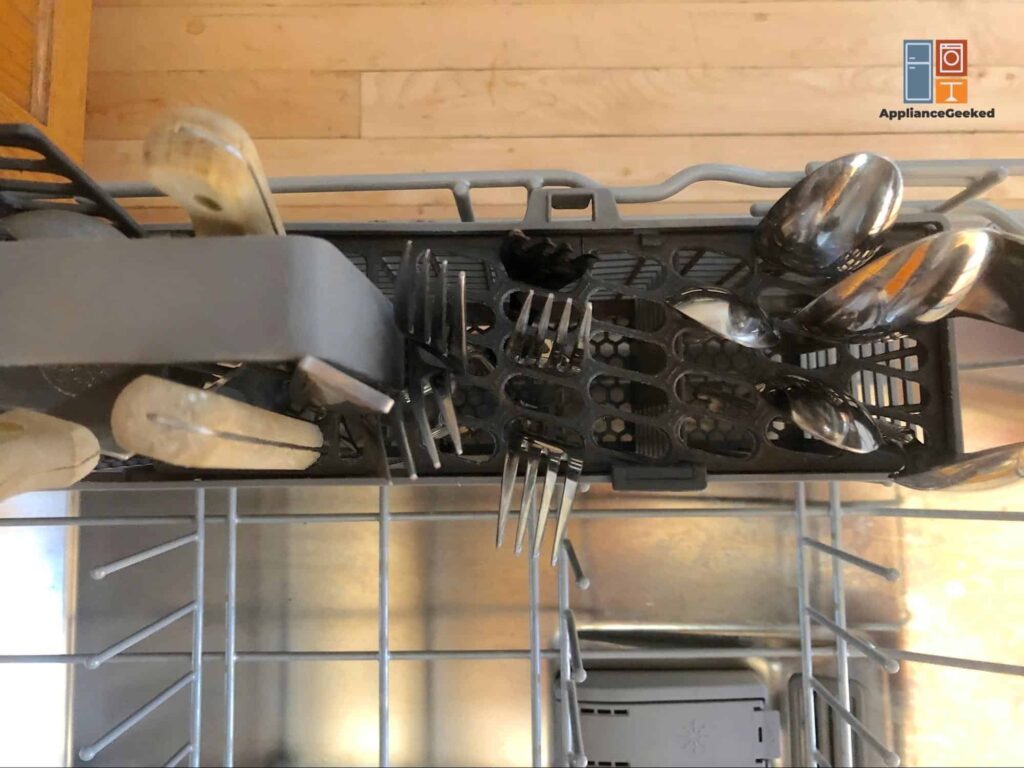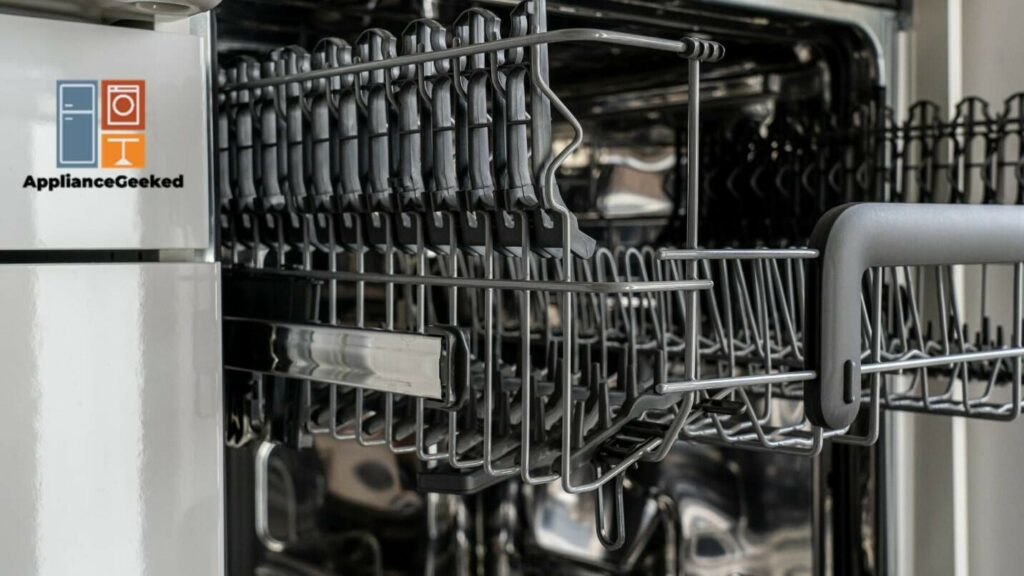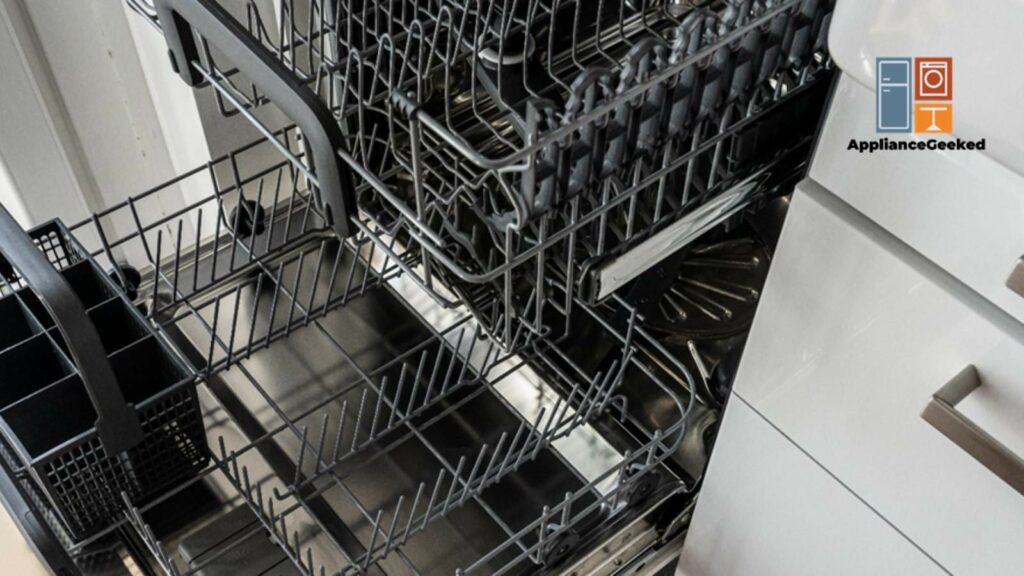If your Whirlpool dishwasher’s drain problem can no longer be fixed with a quick clean-up, the drain pump must be tested for continuity. You can make a service call but you have to be prepared for the costs.
Let’s face it; we all dread appliance repairs because they cost an arm and a leg but are very important to keep your household running smoothly.
Lucky for you, ApplianceGeeked offers easy-to-follow guides to help you troubleshoot and maintain your appliance with ease and confidence. By doing the work yourself, you can save hundreds of dollars in repair costs.
So, be ready to roll up your sleeves and learn how to test your Whirlpool dishwasher drain pump using our guide below.
Whirlpool Dishwasher Drain Pump Test
A continuity test is the most effective way to verify whether your Whirlpool dishwasher’s drain pump is functioning properly or not. During the test, a multimeter sends a small current through the circuit to measure its resistance.
If the drain pump lacks continuity, it is bad and needs replacement.
Inspect the pump for obstructions.
Obstructions are the most common causes of drain problems on Whirlpool dishwashers (whirlpool dishwasher won’t drain). Although a clogged drain pump doesn’t happen as often as a clogged drain hose, it does happen, especially when the filter is broken.
Every dishwasher has a filter that is designed to catch food scraps and other debris from your dishes. Like other components in your dishwasher, this filter will wear and tear over time, which can impair its ability to trap dirt.
If tiny bits of food can pass through the filter, it can accumulate in the sump area and clog up the drain pump. As a result, your dishwasher will be slow to drain or it won’t drain at all.
In such cases, you’ll have to remove the obstructions by hand. Then, you must give your dishwasher a deep cleanse to prevent the drain error from recurring.
Look for visible damage on the pump.
Locate the drain pump on your Whirlpool dishwasher. Then, look for cracks and other visible signs of damage which are clear indicators of a malfunctioning component.
Unfortunately, you can no longer repair a broken drain pump. You must replace it with a new component to get your dishwasher back up and running.
If you have a very old dishwasher, you might want to look into the total costs of the replacement and compare it with the prices of new units on the market. Sometimes, it’s more cost-effective to buy a new unit than to have an old one repaired.
Take note that a manual inspection isn’t the most reliable way to determine drain pump failure. The absence of visible signs of damage doesn’t always indicate a good drain pump.
Thus, if there are no obstructions and visible signs of damage on the pump, but it doesn’t run during drain cycles, then it is likely malfunctioning. You need to perform a continuity test to verify this.
Perform a continuity test on the pump.
Whether due to short circuits or power surges, your dishwasher’s drain pump can malfunction without leaving visible signs of damage. In such cases, a continuity test is the most reliable way to determine if the component is damaged or not.
A continuity test verifies if the component has a complete path for current flow. If the circuit is complete and closed, it has continuity, which means your drain pump is functioning the way it should.
Depending on your multimeter and its settings, it might beep to indicate that the drain pump has continuity. The level of resistance needed to trigger the beep may vary, but most will detect continuity with 0 to 50 ohms.
On the other hand, a lack of continuity indicates that the drain pump is defective. You must replace the component to get your dishwasher to drain properly during wash cycles.
How to Test a Whirlpool Dishwasher Drain Pump for Continuity
To test a drain pump for continuity, isolate it from your Whirlpool dishwasher. Set a multimeter to the lowest setting for ohms of resistance.
Then, touch each probe on the multimeter to a terminal on the drain pump. If the display shows 15 to 40 ohms of resistance, the pump is functioning properly.
Testing a Whirlpool dishwasher drain pump for continuity is easier than you think. With the right tools and the proper guidance, you can complete the test in 30 minutes or less.
What you’ll need:
- Flathead screwdriver
- Towels
- Multimeter
- New drain pump
Safety reminders:
Always isolate the drain pump from the dishwasher before performing a continuity test.
Instructions: To test your Whirlpool dishwasher’s drain pump for continuity, follow these steps carefully:
- Step 1: Unplug your dishwasher or turn off the power at the circuit breaker.
- Step 2: Unthread the screws on the lower access panel. Set aside the panel and the attached insulation.
- Step 3: Locate the drain pump. Place a towel underneath it to absorb any spills.
- Step 4: Depress the retaining tab and rotate it counterclockwise to remove it.
- Step 5: Unhook the wire from its retainer. Then, disconnect it from the pump.
- Step 6: Place the pump on a dry, stable surface where you can test it for continuity.
- Step 7: Get a multimeter and rotate its dial to the lowest setting for ohms of resistance.
- Step 8: Set the black probe on one of the terminals on the drain pump and the red probe on the other terminal.
A multimeter will display around 15 to 40 ohms of resistance if the drain pump’s circuit is closed. Only a closed, complete circuity has continuity.
If there is little to no change on the meter, your drain pump has no electrical continuity and requires replacement.
How to Replace a Whirlpool Dishwasher Drain Pump
A Whirlpool dishwasher drain pump that has no continuity is no longer functioning properly. As mentioned, there’s nothing you can do to repair it, but you can replace the component.
To get your dishwasher to drain properly, you must remove the faulty component and replace it with a factory-specified part for your particular model.
We recommend using Whirlpool replacement parts to avoid further malfunctions in the future.
What you’ll need:
- Flathead screwdriver
- Towels
- Multimeter
- New drain pump
To replace a defective drain pump on a Whirlpool dishwasher, follow these steps:
- Step 1: Unplug your dishwasher or turn off the power at the circuit breaker.
- Step 2: Unthread the screws on the lower access panel. Set aside the panel and the attached insulation.
- Step 3: Locate the drain pump. Place a towel underneath it to absorb any spills.
- Step 4: Depress the retaining tab and rotate it counterclockwise to remove it.
- Step 5: Unhook the wire from its retainer. Then, disconnect it from the defective pump.
- Step 6: Get the replacement part. Plug the wire into the new drain pump and secure the wire into the retainer.
- Step 7: Insert the new pump into the sump housing. Turn it clockwise to lock it into place.
- Step 8: Align the access panel at the bottom of the washer. Make sure it doesn’t touch the float assembly.
- Step 9: Reinstall the screws to secure the access panel.
- Step 10: Restore power to the dishwasher.
- Step 11: Run a test cycle to check if the drain problem is resolved.
Depending on your skills, experience, and level of confidence, this fix should only take about 30 minutes of your time. Compared to other repairs, it is quite easy to do and requires only a few tools.
Signs of a Faulty Whirlpool Dishwasher Drain Pump
A faulty Whirlpool dishwasher drain pump will exhibit these tell-tale signs: 1) standing water, 2) loud buzzing noises, and 3) lack of operations during drain cycles.
These warning signs will alert you of a possible drain pump problem. You can act upon them immediately to prevent a breakdown.
Standing Water after a Wash Cycle
A malfunctioning drain pump will cause your dishwasher to drain slowly or not drain at all. As a result, you’ll usually see standing water at the bottom of the tub of your dishwasher after cycles.
You have to remove the standing water to check the filter and sump area for obstructions. Once you’ve removed all the dirty water, you can vacuum or pick up any dirt build-up by hand that might be preventing the impeller from turning properly.
Say, your dishwasher is free from obstructions, you can test the pump for continuity to determine if it needs a replacement. Instead of waiting for it to fail, you can replace it as soon as possible and avoid appliance downtime.
Loud Unusual Noises
If your drain pump is working harder than it should, you will hear loud buzzing noises during regular operations. This is a tell-tale sign of trouble and, if possible, you should look into it to prevent it from further breaking down.
The loud buzzing noises occur when the pump’s bearings start to wear out. When this happens, the impeller will also struggle to turn, impairing its ability to pump water out of the dishwasher.
As the problem progresses, you will hear continuous squealing noises until you replace the pump with a new one.
For a mechanical issue like this, a quick visual inspection should be enough to confirm that the pump is defective.
Not Running During Drain Cycles
A drain pump that fails electrically won’t always have physical signs of damage.
One of its tell-tale signs is when it stops working completely during drain cycles. That means you won’t hear the pump running and moving water out of the dishwasher.
Whether caused by short circuits or power surges, you can verify that your drain pump is defective by performing a continuity test. If it has failed, you must replace the faulty component.
Tips to Maintain a Dishwasher’s Drain Pump
Routine cleaning is a simple yet effective way to protect a dishwasher’s drain pump. To keep it in tip-top shape, regularly check for and remove obstructions.
Always use the right type of detergent and in the right amount to prevent excess sud production, which can damage the drain pump.
Use the right kind of detergent.
Never use regular dish soap on your Whirlpool dishwasher—or any dishwasher for that matter. If you use the wrong kind of soap, your unit will produce an excessive amount of suds during wash cycles, which don’t drain that easily.
Too much foam can overwork the drain pump, causing it to overheat and malfunction. On top of that, you’ll have a thick, sudsy mess to clean up in your dishwasher and your floors (if it leaks out).
You must only use dishwasher detergent, which is formulated with enzymes that remove food soils effectively by breaking down long chains of protein and starches.
Whether you use pods, powder, or liquid detergent, it will dissolve easily in water and clean the stains on your dishes. We recommend using tablets and packs for the best performance.
Here’s an overview of the most common types of dishwasher detergents.
| Type of Detergent | Price | Performance | Dosage |
| Powder | Budget-friendly | • Might be difficult to distribute evenly • Most effective against mineral build-up • May leave residue on the dishes | • Use 2-3 teaspoons of detergent per load. • Refer to the detergent’s packaging for best results. |
| Liquid | Mid-level price | • Works best with soft water • May leave streaks or spots | • Use at least a tablespoon per load. • Refer to the detergent’s packaging for best results. |
| Pods | Higher price range | • Dissolves easily • Doesn’t leave streaks, spots, or residue | • It comes pre-measured in single-dose packs. • Refer to the detergent’s packaging for best results. |
Use the right amount of detergent.
Aside from using the right kind of detergent, you must also use the right amount to prevent excessive sud production during wash cycles.
If you’re using liquid detergent, only use about a tablespoon and never pour beyond the fill line in your dishwasher dispenser. Heavier loads may require more detergent, so make sure to refer to the product label’s recommendations.
As much as possible, avoid spills. If you do spill detergent near the dispenser area, wipe it off before running a cycle as this can also produce too much foam.
Pods, also known as tablets, are the easiest to use as they come in pre-measured single-dose pouches. All you have to do is pop them in the dispenser without having to worry about spills and excess detergent.
Clean the dishwasher regularly.
Malfunctions can easily be avoided with routine cleaning and maintenance. However, there’s more to it than just running a cleaning cycle on your dishwasher.
To keep your drain pump in optimal condition, you also have to regularly check for obstructions. Removing any build-up before it can cause blockages can help you prevent component failure and appliance breakdowns.
Frequently Asked Questions
The most effective way to determine if your dishwasher’s drain pump has gone bad is by performing a continuity test. After isolating the component, you can use a multimeter to check if the circuit is open or closed.
During the test, you will place each probe on a terminal on the drain pump. If the multimeter shows 15 to 40 ohms of resistance, it means the component has electrical continuity and should be functioning properly.
Little to no change indicates that the drain pump has no continuity and a replacement is necessary.
Depending on your dishwasher’s make or model, a new drain pump can cost around $40 to over $250 dollars. On higher-end models, a replacement can even cost as much as $600.
Take note that this price is for the pump alone and doesn’t include the costs needed for replacement. If you request service, you can expect to spend an extra hundred dollars or more.
To cut hefty repair costs, you can perform the replacement yourself. With ApplianceGeeked’s repair guide, you can carry out the fix with confidence and save hundreds of dollars on repair costs.
Yes. If your filter is damaged and unable to catch food scraps effectively, all that debris will accumulate in the sump area and clog the drain pump, impairing its ability to drain the dirty water from the cycles.
As long as the pump isn’t defective, you can remove any obstructions in the pump area by hand and give it a good clean to fix the problem.
With proper care and maintenance, your dishwasher, along with its drain pump, can last for an average of 10 to 12 years. You can prolong its lifespan and reduce breakdowns by being proactive with cleaning and maintenance.
By keeping the dishwasher running smoothly, you can avoid hefty costs for repairs and replacements. You can enjoy freshly cleaned dishes after every wash.




